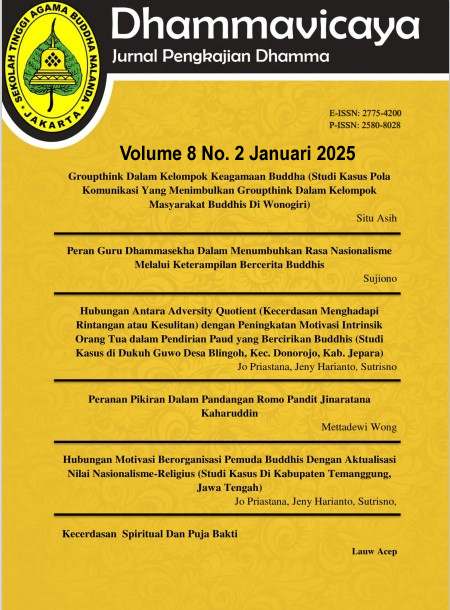Religious Aspects Behind the Behaviour of Swearing ‘Anjing’: The Perspective of Indonesia’s Religious Leaders
DOI:
https://doi.org/10.47861/dhammavicaya.v8i2.1362Keywords:
Dog, object of invective, religious leaders, swearingAbstract
Swearing can be seen in the objects chosen for insults, which are often animals. In Indonesia, the term “Anjing” or Dog is frequently used in swearing by both students and the general public. This choice is believed to be influenced by the beliefs of the majority Muslim population, who consider dogs to be impure and forbidden. The goal of this study is to explore the religious aspects of using 'Anjing' as an insult from the perspective of religious leaders in Indonesia. The research aims to show that using “Anjing” as an insult is not only based on Islamic beliefs but is also connected to other religions. This study uses a qualitative approach with document analysis and interviews with five religious’ leaders from different faiths. The findings suggest that in Islam, dogs are not inherently unclean, but their saliva is considered impure. In Christianity, both Catholic and Protestant, 'Dog' has been used historically as an insult by Jews against other religions. In Hinduism, dogs are used in rituals to remove negative energy, and in Buddhism, dogs represent karmic punishment for failed reincarnation. In Confucianism, dogs can be both helpful and harmful, so they are allowed to be eaten. All religions agree that swearing is harmful and has negative effects, both immediately and in the future.
References
Ackerman-Lieberman, P., & Zalashik, R. (2014). A Jew’s best friend: The image of the dog throughout Jewish history (1st ed.). Sussex Academic.
Adilang, R., & Kalundang, A. (2023). “Remah untuk Anjing” Memahami perilaku Yesus dan respon perempuan dalam Markus 7:24-30. DAAT: Jurnal Teologi Kristen, 4(1), 1–14. https://doi.org/10.51667/djtk.v4i1.1252
Anshari, F., Purnama, V. C., & Patiyah, J. R. (2023). Finding moments of Indonesian football supporters emotionally swearing at the word ‘Anjing’ [Paper presentation]. The 4th Jogjakarta Communication Conference.
Anshari, F., Purnama, V. C., & Sari, H. P. P. (2023). The culture of swearing ‘Anjing’: An ethnography study of Indonesian football supporters. Grounding Communication for Sustainable Development Towards the Digital 5.0 Era, 526–540.
Anshari, F., Sari, H. P., & Suryani, H. (2024). Kegiatan “Mystery Box” untuk melihat pemaknaan kata “Anjing” sebagai bahasa keseharian. Indonesian Journal of Civil Society, 6(2), 1–10. https://doi.org/10.35970/madani.v1i1.2198
Beasley, S. C. (2019). Kindness for all creatures: Buddhist advice for compassionate animal care (1st ed.). Shambhala Publications.
Creswell, W. J., & Creswell, J. D. (2018). Research design: Qualitative, quantitative, and mixed methods approaches (5th ed.). SAGE Publications Inc.
Fägersten, K. B., & Bednarek, M. (2022). The evolution of swearing in television catchphrases. Journal of Language and Literature, 31(2), 196–226. https://doi.org/10.1177/09639470221090371
Forth, G. (2019). A dog pissing at the edge of a path: Animal metaphors in an Eastern Indonesia society (1st ed.). McGill-Queen’s University Press.
Generous, M. A., & Houser, M. L. (2019). “Oh, shit! Did I just swear in class?”: Using emotional response theory to understand the role of instructor swearing in the college classroom. Journal of Communication Quarterly, 67(2), 178–198. https://doi.org/10.1080/01463373.2019.1573200
Hefner, R. W. (2018). Routledge handbook of contemporary Indonesia (1st ed.). Routledge. https://doi.org/10.4324/9781315628837
Isnawan, F. (2021). Pandangan hukum Islam terhadap fenomena penggunaan kata “Anjay” dalam pergaulan remaja. Jurnal Darussalam: Jurnal Pendidikan, Komunikasi dan Pemikiran Hukum Islam, 13(1), 115–135.
Kharputly, N. (2020). Whose best friend? Muslims, dogs, and the making of humanity. Society and Animals, 29(106), 1–17. https://doi.org/10.1163/15685306-BJA10016
Kristan, G. (2021). Pendidikan Agama Khonghucu dan Budi Pekerti (1st ed.). BPPP Kementerian Pendidikan, Kebudayaan, Riset, dan Teknologi.
Lafreniere, K. C., Moore, S. G., & Fisher, R. J. (2022). The power of profanity: The meaning and impact of swear words in word of mouth. Journal of Marketing Research, 59(5), 908–925. https://doi.org/10.1177/00222437221078606
Miller, P. C. (2018). In the eye of the animal: Zoological imagination in Ancient Christianity (1st ed.). University of Pennsylvania Press.
Mufrodah, A., & Adinugraha, H. H. (2021). Millennial generation’s awareness of halal-labeled cosmetics. Al Ma’arief: Jurnal Pendidikan Sosial dan Budaya, 3(2). https://doi.org/10.35905/almaarief.v3i2
Neuman, W. L. (2014). Social research methods: Qualitative and quantitative approaches (7th ed.). Pearson Education.
Reiman, A. K., & Earleywine, M. (2022). Swear word fluency, verbal fluency, vocabulary, personality, and drug involvement. Journal of Individual Differences, 22(1). https://doi.org/10.1027/1614-0001/a000379
Ro, Y.-C. (2021). Dao companion to Korean Confucian philosophy (2nd ed.). Springer.
Ropi, I. (2017). Religion and regulation in Indonesia (1st ed.). Palgrave Macmillan. https://doi.org/10.1007/978-981-10-2827-4
Sapanti, I. R., & Suswandi, I. (2022). Perluasan makna dan variasi kata anjing pada generasi milenial. Nusa, 17(2), 152–163.
Shakiba, N., & Stapleton, K. (2022). Persian immigrants’ language choice for swearing: The effects of socio-biographical variables and personality traits. Journal of Multilingual and Multicultural Development, 43(5), 1–18. https://doi.org/10.1080/01434632.2022.2068559
Stapleton, K., Beers Fägersten, K., Stephens, R., & Loveday, C. (2022). The power of swearing: What we know and what we don’t. Lingua, 277. https://doi.org/10.1016/j.lingua.2022.103406
Stephens, R., & Umland, C. (2011). Swearing as a response to pain - Effect of daily swearing frequency. Journal of Pain, 12(12), 1274–1281. https://doi.org/10.1016/j.jpain.2011.09.004
Stephens, R., Dowber, H., Barrie, A., Almeida, S., & Atkins, K. (2022). Effect of swearing on strength: Disinhibition as a potential mediator. Quarterly Journal of Experimental Psychology, 15(2), 1–14. https://doi.org/10.1177/17470218221082657
Suhardi, U., Oktaviani, L., Biasa, I. M., Sugiarta, I. W. A., & Prameswara, I. (2020). Kedudukan dan peran badan penyiaran Hindu dalam pembinaan kehidupan keagamaan di Indonesia. Jurnal Dhammavicaya, 4(1), 14–21. https://doi.org/10.47861/dv.v4i1.23
Sukarti, S. (2023). Harmonisasi sosial pada perilaku keagamaan masyarakat Buddhis dan Muslim dalam kajian Upali Sutta. Jurnal Pendidikan, Sains Sosial, dan Agama, 9(1), 33–42. https://doi.org/10.53565/pssa.v9i1.646
Weimer, A., Koniakowsky, I., Nazir, T. A., & Huckauf, A. (2022). Behavioral evidence for differences in emotional resonance during processing first and second language. International Journal of Bilingualism, 15(1), 1–15. https://doi.org/10.1177/13670069211073578
Wheeler, B. (2022). Animal sacrifice and the origins of Islam (1st ed.). Cambridge University Press.
Wiranata, A. A. G. (2020). Etika Hindu dalam kehidupan. Widya Katambung: Jurnal Filsafat Agama Hindu, 11(1), 1–17. https://doi.org/10.33363/wk.v11i1.498
Downloads
Published
How to Cite
Issue
Section
License
Copyright (c) 2025 Dhammavicaya : Jurnal Pengkajian Dhamma

This work is licensed under a Creative Commons Attribution-NonCommercial-ShareAlike 4.0 International License.






